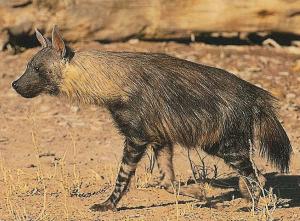Facts About Brown hyena
The brown hyena, also known as the strandwolf, is a rare and captivating species of hyena. Found in Namibia, Botswana, Zimbabwe, Mozambique, and South Africa, its largest populations flourish in the southern Kalahari Desert and along the coast of Southwest Africa. With an estimated global population ranging from 4,000 to 10,000 individuals, the brown hyena is currently classified as Near Threatened on the IUCN Red List.
These hyenas display remarkable adaptability, inhabiting deserts, semi-deserts, and open woodland savannahs. They can even survive near urban areas by scavenging for food, although they prefer rocky, mountainous regions. You can identify a brown hyena by its long, shaggy dark brown coat, pointed ears, and short tail. One of their distinctive features is a cream-colored fur ruff around their necks, and they are renowned for their powerful jaws. Brown hyenas live in social structures akin to those of wolves, forming clans composed of extended family members.
Unlike some animals, brown hyenas do not have a specific breeding season. Females typically give birth to litters of 1-5 cubs, which are born with their eyes closed and are weaned at around 12 months. Their diet primarily consists of scavenged carcasses, but they also consume rodents, insects, eggs, and fruit. Thanks to their excellent sense of smell, they can detect carcasses from several kilometers away.
Unfortunately, brown hyenas face significant threats, primarily from human persecution due to misconceptions about their impact on livestock. To protect these unique creatures, various conservation efforts are underway. Protected areas such as Etosha National Park, Central Kalahari Game Reserve, and Kgalagadi Transfrontier Park are essential for their survival. Additionally, educational campaigns aim to raise awareness and dispel myths about hyenas. Problem individuals are often relocated from farmlands and urban areas to ensure their safety and preservation.

 South Africa
South Africa